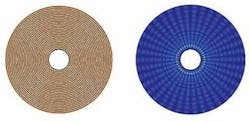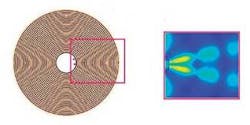
Structured optical metamaterials may one day be the basis for a “superlens” that can image at beyond the diffraction limit. But structured metamaterials that operate in the optical regime and are practical to fabricate into a superlens remain a dream (although single-film superlenses are already practical; see “Superlens enhances near-field scanning microscopy,” p. 34). This dream may be a bit closer to reality, however, with the (as yet theoretical) conception of a practical superlens by researchers at Princeton University (Princeton, NJ).1
The concept can either be applied to imaging in one dimension, similar to a cylindrical lens, (easier to fabricate for early experimentation), or imaging in two dimensions like a spherical lens (harder to fabricate, but ultimately more useful). In the 1-D approach, a hollow cylinder is created of alternating concentric subwavelength layers of metal and dielectric materials (see figure). (In an alternate approach, the layers are configured radially, but that would be more difficult to fabricate.) The layers create a highly cylindrically anisotropic metamaterial with a hyperbolic form of dispersion relation; for this reason, the researchers dub the structure a “hyperlens.”
Bringing subwavelength to the world
Contrary to a solid dielectric cylinder, the cylindrical hyperlens allows photons with high angular-momentum states to exist near the center of the cylinder (in a uniform-dielectric cylinder, such photons skip along near the outer surface). Photons with high angular-momentum states carry subwavelength information; in a hyperlens, they can carry that information from subwavelength objects placed inside the cylinder’s inner diameter all the way to the cylinder’s outer surface, where the objects appear to the outside world magnified to sizes of greater than a wavelength-and thus visible with ordinary optics.Spherical versions of the hyperlens are possible, says Evgenii Narimanov, one of the researchers. “Obviously, such a 3-D device will be harder to make,” he notes. “So we expect the first experimental demonstration of the hyperlens to be in the cylindrical geometry. Several experimental groups are already working on different realizations of the hyperlens, using different fabrication techniques (such as focused ion beam) to make the device. I expect the first experimental demonstration to appear within a year.” Potential uses include subwavelength imaging of biological structures.
REFERENCE
1. Z. Jacob et al., Optics Express 14(18) (Sept. 4, 2006).
About the Author
John Wallace
Senior Technical Editor (1998-2022)
John Wallace was with Laser Focus World for nearly 25 years, retiring in late June 2022. He obtained a bachelor's degree in mechanical engineering and physics at Rutgers University and a master's in optical engineering at the University of Rochester. Before becoming an editor, John worked as an engineer at RCA, Exxon, Eastman Kodak, and GCA Corporation.


